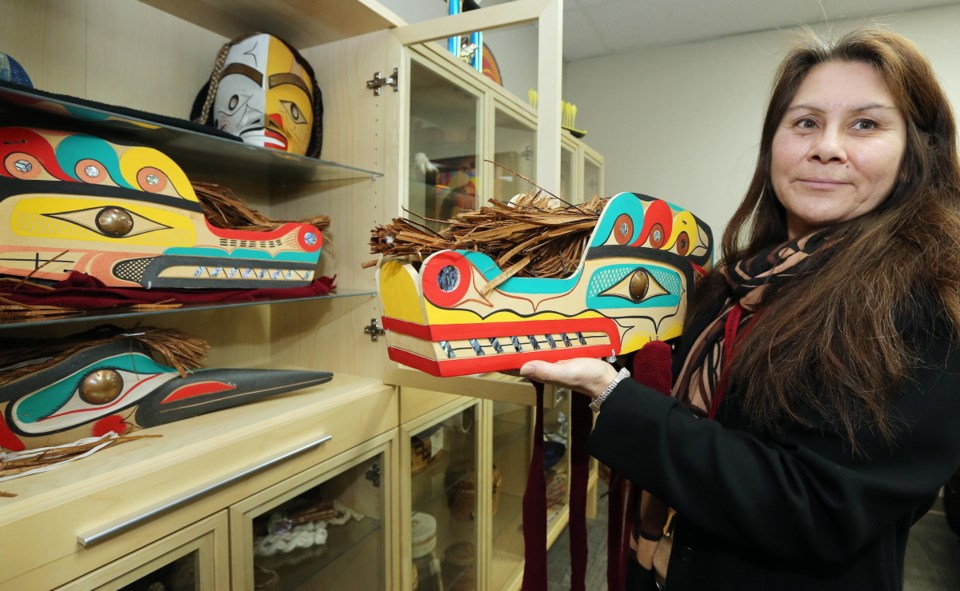Sabrina Williams sees the transformative power of connecting aboriginal children in foster care to their lineage, communities and cultural traditions in her work time and again.
“Finding out who you are and where you come from gives a person a sense of completeness, a place to start,” said Williams, the cultural programs co-ordinator at Surrounded by Cedar Child and Family Services, the View Royal-based hub for urban aboriginal social services in Greater Victoria.
She shared examples: A young person finds out they have a relative in a First Nation who wants to know them; at monthly dinners, local elders share practical and life knowledge with youth; an Ojibway child recently welcomed by members of that community with a ceremony and promise to be lifelong “aunties.”
“We find out where they are from, what the linkages are and try to establish a sense of belonging in general. … These are very urban kids, so it’s also important to get them to the land to connect, as well,” said Williams, who is from the Cowichan Tribes area.
Williams, a 54-year-old mother of five adult children, was recently named an Award of Excellence recipient by the Federation of Community Social Services of B.C. for her work connecting children in care to their aboriginal heritage.
“She’s one of those tireless workers who is always thinking of new opportunities and ways to do things. In this day and age, that’s an important thing,” said Rick FitzZaland, executive director of the federation.
“People like her aren’t the ones that always make the news. … But there’s a large group of people working hard, sacrificing their own agendas to help others.”
Williams said she was pleased to have her work recognized, but hopes it translates into more support from agency funders.
“There’s an inequality for aboriginal funding,” Williams said, citing increasing workload and need while provincial funding for programs is cut back.
More than half of the nearly 10,000 children in foster care in B.C. are aboriginal, though they make up only eight per cent of youth in B.C. The majority of aboriginal children in foster care do not live with aboriginal families.
Aboriginal youth and youth in care are also largely overrepresented in the justice system. According to the 2013 report, Time Out: A Profile of B.C. Youth in Custody by the McCreary Centre Society, 52 per cent of the youth in custody who were surveyed identified as aboriginal and 65 per cent had been in some form of government care. The majority of aboriginal youth surveyed had never lived on a reserve and only 16 per cent spoke a traditional language at home.
However, the report did note a positive correlation between aboriginal programs, knowledge, cultural connections and future aspirations among the youth.
“For some of the kids in our programs, the cultural aspects are foreign to them, so we integrate recreational activities and focus on wellness,” Williams said. “The important thing is to show them they have a community that is there for them.”
One of the ways Surrounded by Cedar does that is by holding ceremonies for youth who are about to age out of care — to show them they are still part of a community.
Mena Williams, a Hul’qumi’num language instructor in the Cowichan Tribes territory, has helped youth from Williams’s programs learn about language and cultural practices.
“Everything is rooted in language. It is so important. It’s the foundation of culture,” said Williams. She noted an example: There is not just one word for “share” in Hul’qumi’num but several specific to the context.
Williams said some of the youth on a cultural exchange to her territory saw a fish smokehouse, a sweat lodge and traditional methods of fishing for the first time.
“They thought it was phenomenal,” she said, adding programs like Williams’s are a necessity with so many First Nations children in care. “There are too many in care, more than in residential schools — and many of the dynamics are the same.”
Williams said the greatest resource for her programs are the many teachers and elders who volunteer, passing on cultural knowledge and building mutual respect. Many of the kids come back as mentors themselves.
But it all comes back to knowing yourself, Williams said.
“If I were to dream big, I would like to be able to do more cultural exchanges across Canada, because some of these kids have never been to their communities,” she said. “Our cultures are all so different — the languages, the regalia — but underneath, they all resonate with similar values. That would be really amazing to be able to show that.”



